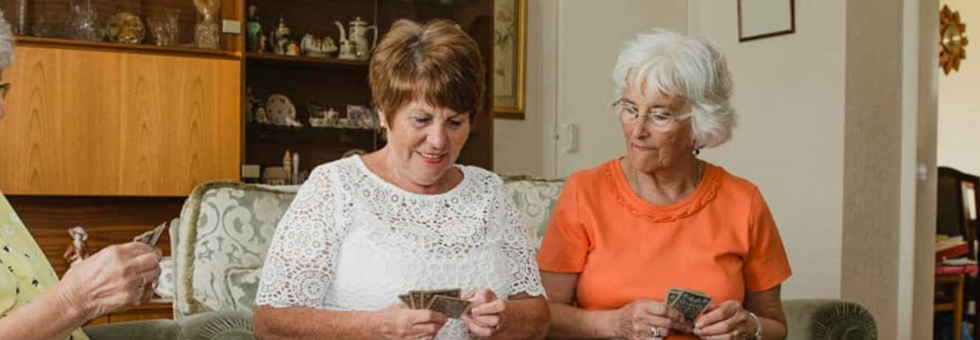Contents
This stage of the case study provides the following information.
- The Personal History sets out what is happening for Don and Madge.
- Values and Ethics – Relating to individualisation and identity
- Law and policy – Relating to: Review; Mental health policy; Improving Access to Psychological Therapies
- Knowledge, Evidence and Good Practice – Relating to: Talking therapy and older people; Companion animals; Communication and resources following stroke;
- Skills – Relating to: Communication; Engaging with carers; Utilising local resources
- Activities – Relating to: Review process; Older people and talking therapy; Utilising local resources; Individuation
- Additional resources – Relating to: Companion animals; Communication after stroke
Personal History
Following a review meeting in early February, the social worker, Jodie, made a further assessment of Don’s needs and developed a care plan which included attention to Don’s emotional needs and mental health. Specifically, Don’s communication difficulties and his anxiety symptoms, and their implications for his well-being, were actively considered and addressed. Don was referred to the local Improving Access to Psychological Therapies (IAPT) service which was helpful as he felt that they understood his intense anxiety. Don was also prescribed anti-depressant medication and visited by a CPN who monitored this and his mental state.
An important source of longer term emotional support came from the local Stroke Association’s voluntary visitor service. The visitor was a local woman who had known Madge well in the gardening group. It was so helpful for Don to be able to talk about Madge and share memories with someone who knew her, her many strengths and abilities. The local Cinnamon Trust gave some help with Sprocket and a volunteer walked him regularly. This helped Don to feel less anxious about his dog and provided another source of human contact.
During this time, Don felt a small, but significant, improvement in mood. Although he continued to feel low and anxious at times, he felt a little more in control following the intervention from an empathic and skilled social worker who had recognised his distress and the jeopardy that he faced. Support from the mental health team and the voluntary sector had contributed to a sense that he was not alone.
Values and Ethics
Individualisation is a traditional social work value and one of Biestek’s (1961) casework principles (see Banks, 2012). When working with Don, this means recognising his unique qualities and attributes and his right ‘to be treated not just as a human being but as this human being’ (Banks, 2012: 46). Engaging in critical social work practice also means taking account of the impact of social structural factors, such as gender, ethnicity and age, on his identity, circumstances and personal meanings (Dominelli, 2002).
In the early stages of working with Don, it is important to generate hypotheses rather than to make assumptions about his needs (Milner and O’Byrne, 2009). For example, one hypothesis to explore further might be that as Don spent his working life in a male-dominated environment, he misses male companionship. Male-specific activities can help to reduce social isolation and loneliness in men (Beach and Barnford, 2014). This is an example of viewing Don as an individual with a unique life history, needs and preferences. ‘Best practice’ involves finding creative solutions (Jones and Watson, 2013) and if the hypothesis proves correct, the social worker could explore ways of re-engaging Don with male companionship.
Don is feeling more positive in this phase of his care journey and it seems that some aspects of his needs and concerns have been responded to appropriately. For example, his attachment to Sprocket has been recognised and Don does not need to worry about taking Sprocket for walks as a volunteer now helps with this. At the same time, the volunteer is a source of social contact for Don and someone to whom he can talk about Sprocket. Similarly, the volunteer from the Stroke Association can share with Don memories of Madge and an interest in gardening.
Recognising Don as an unique individual means understanding the important relationships and experiences that provide links between his past, present and future; these include memories of Madge, his home, Sprocket and interests in gardening and steam engines. Gerontological theory recognises the significance of continuity, that is, ongoing threads across the life course that give a sense of identity and meaning. Research has attested to the significance for older people of continuous life themes, particularly concerning relationships with family and friends (Coleman et al, 1998). Post-modern theories emphasise individual agency in terms of the person’s capacity to make choices and adapt. Although there may be continuous themes, identity is also seen as fluid and responsive to change, rather than fixed (Gilleard, 1996). These different theoretical perspectives highlight the need to perceive Don as a unique individual and to understand him within the context of his life history and the personal meanings that places, people and events hold for him (Frost and McClean, 2014). Biographical and narrative approaches that encourage him to tell stories about his life and experiences, and to reconstruct stories in different ways so that his life has value and purpose, are ways of enacting in practice the social work values of individualisation and respect for persons.
Older person’s comments:
On one hand, it’s really good that in this phase of the case study Don seems to be getting the right help and to be feeling more positive. But it’s important to remember what it can be like for an older person (and the carer). I drew an ecomap and this shows the large number of people involved in Don’s care. Who is pulling this together and managing it? Often there is a big flurry of activity to begin with and this can feel overwhelming if lots of people suddenly descend on your home. But then things are not followed through or don’t work out and then the person can be left with nothing, or very little, and feel abandoned. So although the social worker may be geared to putting in lots of help, it is important to put the pieces of the jigsaw together and think about what this will feel like for the person.
References
Banks, S. (2012) 4th edn. Ethics and Values in Social Work, Basingstoke: Palgrave Macmillan.
Beach, B. and Barnford, S. (2014) A report exploring experiences of social isolation and loneliness among older men in England, London: Independent Age.
Coleman, P., Ivani-Chalian, C. and Robinson, M. (1998) ‘The story continues: persistence of life themes in old age’, Ageing and Society 18: 389-419.
Dominelli, L. (2002) Anti-oppressive Social Work Theory and Practice, Basingstoke: Palgrave Macmillan.
Frost, L. and McClean, S. (2014) Thinking about the Lifecourse: A psychosocial introduction, Basingstoke: Palgrave Macmillan.
Gilleard, C. (1996) ‘Consumption and identity in later life: toward a cultural gerontology, Ageing and Society 16: 489-98.
Milner, J. and O’Byrne, P. (2009) 3rd edn, Assessment in Social Work, Basingstoke: Palgrave Macmillan.
Law and Policy
Don has a care and support plan in place so the Local Authority has a legal responsibility to review it (Care Act 2014, s.27).
(1) A local authority must—
(a) keep under review generally care and support plans, and support plans, that it has prepared, and
(b) on a reasonable request by or on behalf of the adult to whom a care and support plan relates or the carer to whom a support plan relates, review the plan.
(2) A local authority may revise a care and support plan; and in deciding whether or how to do so, it—
(a) must have regard in particular to the matters referred to in section 9(4) (and specified in the plan under section 25(1)(d)), and
(b) must involve—
(i) the adult to whom the plan relates,
(ii) any carer that the adult has, and
(iii) any person whom the adult asks the authority to involve or, where the adult lacks capacity to ask the authority to do that, any person who appears to the authority to be interested in the adult’s welfare.
(3) A local authority may revise a support plan; and in deciding whether or how to do so, it—
(a) must have regard in particular to the matters referred to in section 10(5) and (6) (and specified in the plan under section 25(1)(d)), and
(b) must involve—
(i) the carer to whom the plan relates,
(ii) the adult needing care, if the carer asks the authority to do so, and
(iii) any other person whom the carer asks the authority to involve.
(4) Where a local authority is satisfied that circumstances have changed in a way that affects a care and support plan or a support plan, the authority must—
(a) to the extent it thinks appropriate, carry out a needs or carer’s assessment, carry out a financial assessment and make a determination under section 13(1), and
(b) revise the care and support plan or support plan accordingly.
(5) Where, in a case within subsection (4), the local authority is proposing to change how it meets the needs in question, it must, in performing the duty under subsection (2)(b)(i) or (3)(b)(i), take all reasonable steps to reach agreement with the adult concerned about how it should meet those needs.
As Don was discharged from hospital two months ago, good practice would indicate the need for a planned review at around this time to make sure that the care and support plan is meeting his needs and that the outcomes detailed on the plan are being met. However, reviews can also be unplanned, triggered by a change of needs, or may be requested at any time by Don himself, Charlie or a third party, such as Karen or the care provider organisation.
Don’s care and support plan must not be revised until a review has been carried out. Don, Charlie, Don’s advocate and relevant practitioners/professionals should be involved in the review.
Statutory guidance (DH 2016: para 13.12) indicates questions that should be considered in the review, including:
- Have Don’s circumstances and/or care and support needs changed?
- What is working in the plan, what is not working, and what might need to change?
- Have the outcomes identified in the plan been achieved or not?
- Does Don have new outcomes he wants to meet?
- Could improvements be made to achieve better outcomes?
- Is Don’s personal budget enabling him to meet his needs and the outcomes identified in their plan and is the current method of managing it still the best one for what he wants to achieve e.g. should a direct payment be considered?
- Is the personal budget still meeting the sufficiency test?
- Are there any changes in Don’s informal and community support networks which might impact negatively or positively on the plan?
- Are Don, Charlie and the independent advocate satisfied with the plan?
In Don’s situation, it is likely that the review will identify the need to revise the care and support plan. This means revisiting the assessment and care planning process (For further information about assessment and care planning see Section 4). However, ‘re-assessment’ means building on what is already known, rather than starting the assessment from the beginning. The process outlined in the guidance is:
- review whether a reassessment is required and, if so –
- reassess the needs and desired outcomes;
- revise the care and support plan and personal budget.
‘Outcomes’ here refer to personal goals; the review process looks at ‘what is working and not working for the person and checks how much progress has been made towards the goals’ (Bennett et al., 2009: 7).
Statutory guidance (DH 2016: para.13.26) requires that if the plan is revised, Don or the person acting on his behalf must be informed of the decision. After a new care and support plan has been agreed, a ‘light-touch’ review should be considered 6 to 8 weeks later to check whether the arrangements are working well and whether any further adjustments are necessary (DH 2016: para.13.32).
A review of evidence carried out for SCIE prior to the implementation of the Care Act highlighted a number of barriers to reviews being carried out in practice, including the organisational separation and role fragmentation of assessment and review functions and the lack of priority given to reviews because of workload pressures. The review concluded, ‘Conceiving of review as a continuous process rather than a discrete event may ensure desired outcomes continue to be achieved’ (Glendinning et al., 2006: 19).
Practitioner comments:In my local authority, reviews are often carried out over the telephone, usually once every twelve months for what are seen as ‘standard’ cases. The social worker wouldn’t have time to look through old notes and is unlikely to have met the person before so they would look at the last care plan and talk through that with the person on the phone. This can be difficult as many older people do not like talking on the phone or have some form of sensory impairment or may have limited English. Doing reviews over the phone also means that the social worker cannot assess the environment or use observations to help assess the person’s wellbeing. We are totally reliant on what they say. We also cannot assess the dynamics in the relationships between the older person and other people involved in their care.
Some social workers refuse to do reviews over the phone and insist on seeing the person. Don’s situation is likely to be regarded as ‘complex’ so he would receive a face-to-face review visit from a qualified social worker. However, as we don’t keep cases open unless there are ongoing issues, this is unlikely to be the same person who set up the care plan originally.
References
Bennett, T., Cattermole, M., Sanderson, H. (2009) Outcome-focused reviews: A practical guide, London: Department of Health
Department of Health (2016) Care and Support: Statutory Guidance Issued under the Care Act 2014 (Chapter 13: Review of care and support plans). London: Department of Health.
Glendinning, C., Clarke, S., Hare, P., Kotchetkova, I., Maddison, J. and Newbronner, L. (2006)
Outcomes-focused services for older people, SCIE Knowledge Review 13, York: Social Care Institute for Excellence.
b) Mental Health Policy
Don is likely to encounter more obstacles to having his mental health needs recognised and addressed than someone of working age. Mental health service provision in England has moved away from specialist mental health services for older people to generic single-age services, but age discrimination continues to be a feature of mental health services. A survey conducted by the Policy Unit of the Royal College of Psychiatrists in 2010 concluded:
‘There is unequivocal evidence of discrimination against older people in mental health services in the UK fuelled by the approach to national policy implementation, which has promoted the needs of working-age adults and excluded older people’
(Anderson et al, 2013: 98).
The survey highlighted that older people did not have equality of access to mental health services even when these were officially available to them. The greatest inequality was for crisis resolution home treatment and assertive outreach services, either of which Don might require if there is an exacerbation of his mental health problems. The researchers are skeptical about moves to single age-inclusive services. They argue that the evidence base indicates that specialist mental health services are more effective in promoting access and effective treatment.
Inequality of access to mental health services by older people is openly acknowledged in recent policy. A cross-governmental mental health strategy emphasised that it was an outcomes strategy for people of all ages (HM Government 2011). It recognised that although depression is the most prevalent mental health problem experienced by older people, there is a low rate of diagnosis and treatment, despite evidence that older people respond well to treatment. It announced, ‘We will pay particular attention to ensuring appropriate access for people over 65 years of age’ (para 6.15).
Practitioner comment:
In my local authority, there are mental health teams and older people teams. I was working with a man aged 70 who had schizophrenia for many years. But because he was over 65, the mental health team would not work with him and he was dealt with as ‘an older adult’. This meant that he was deprived of the mental health expertise that the mental health team could have offered. The Older Adult team may understand more about problems of later life, but we don’t have specialist knowledge about mental health. Categorising people in this narrow way means that no-one is working with the whole person.
Older person’s comment:
My husband’s problems were complex and he was continually bounced around between departments and teams as he didn’t really fit anywhere and it felt as though no-one wanted to get to grips with his problems. Looking back, I feel as though a lot of the problems started when I asked for help. After that, it was all about disagreeing with incorrect information, fighting for this and challenging that. It was exhausting and soul-destroying, quite apart from the stresses and demands of being a full-time carer.
References
Anderson, D., Connelly, P., Meier, R. and McCracken C. (2013) Mental health service discrimination against older people, The Psychiatrist, 37, 98-103, doi: 10.1192/pb.bp.112.040097
HM Government (2011) No Health without Mental Health: A cross-government mental health outcomes strategy for people of all ages, London: HM Government/Department of Health
c) Improving Access to Psychological Therapies (IAPT)
Don has been referred to Improving Access to Psychological Therapies (IAPT) service and he has found this helpful. Although initially targeted at people of working age, the IAPT programme was extended to adults of all ages in 2010. Don is fortunate to have accessed IAPT as older people are under-represented amongst users of the IAPT service.
Although 12.77% of the English population were aged 65+ in 2013/14, only 5.6% of all referrals to IAPT were aged 65 and over (IAPT, n.d.). Barriers to referral and service usage identified by IAPT include: lack of awareness that IAPT is an all-age service; a perception that older people are less likely to benefit from talking therapies; access difficulties, such as mobility and sensory impairments; and lack of understanding by staff of the issues experienced by older people. People from BME communities face additional barriers to accessing talking therapies so older people from ethnic minority backgrounds may be doubly disadvantaged (Mind, 2013).
A Department of Health Action Plan (2011) to expand access to psychological therapies noted:
Clearly, older people have been significantly under-represented in IAPT services’ patient profiles. This is a matter of concern that must be tackled, especially as age is a protected characteristic under the Equality Act 2010 and public bodies have a duty to ban age discrimination in services from April 2012. The legislation means that IAPT services have a legal responsibility to demonstrate that older people and other protected groups are safe from discriminatory practices (para 36).
The value base of social workers requires them to challenge discrimination and to promote social justice so addressing barriers to referral and access of IAPT service by older people is part of their professional, as well as legal, responsibility.
‘What older people should expect from IAPT services’ video

Practitioner comment:
I’ve been a social worker working with older people for several years, but I’ve never heard of IAPT. When I saw it in this case study, I had to Google it to find out what it was.
Older person comment:
I have never heard of it either. For many years, I was a carer for my husband who had many of the same problems as Don. No-one has ever mentioned IAPT to me and I’ve never seen any information about it.
References
Department of Health (2011) Talking therapies: A four-year plan of action, London: Department of Health
Improving Access to Psychological Therapies (IAPT) (n.d.) Older People, NHS IAPT.
Mind (2013) We still need to talk: A report on access to talking therapies, London: Mind.
Knowledge, Evidence and Good Practice
a) Talking therapy and older people
Talking therapy, in the sense of forms of talk that can be therapeutic for older people and help them cope with the challenges of everyday living, encompasses opportunities to talk within confiding relationships with family or friends, as well as formal counselling in relationships with skilled professionals (Forte, 2009).
It is important not to see Don’s limited mobility and speech impairment as indicators against the use of talking therapy when these same factors may have increased the need for it. Depending on the severity of Don’s speech and language impairments, the methods of therapeutic work may need to be adapted, but this is not insurmountable. Terry (2008) describes undertaking psychotherapy with an older man, Michael, who had lost his ability to speak following a stroke. Terry refers to ‘establishing a vocabulary’ (p.62) with Michael, which included interpreting his non-verbal behaviour, and concludes: ‘Having someone trying to think about and make sense of experiences for which there are no longer words can help these patients feel held’ (p.69). Although social workers are not psychotherapists, they can nevertheless usefully draw on therapeutic skills. Howe (2008: 183) writes,
‘If service users are to explore their feelings they must feel that the professional relationship provides a safe, holding environment. This is facilitated by practitioners who acknowledge the user’s feelings no matter how distressing or ugly those feelings might be. The feelings are not judged, they are simply accepted. This validates and affirms the feelings… If the worker can help users contain their feelings and stay with them, the emotions can be thought about, understood and regulated’ (emphasis as original)’.
This applies as much to older people as younger service users.
Hill and Brettle (2006) undertook a systematic review to find out whether there is evidence to support the use of counselling interventions with older people. The two approaches that featured most prominently in the evidence they reviewed were cognitive behavioural therapy (CBT) and life reminiscence and life review. Hill and Brettle conclude that counselling is effective with older people, particularly in treating anxiety and depression and in improving subjective well‐being. They found that the outcomes obtained from counselling older people were comparable to those achieved with young people, therefore arguing that older people should have equal access to this form of therapy. Although having medical conditions may affect the effectiveness of therapy (for example by disrupting the continuity of sessions), poor health and disabilities may in themselves act as triggers for psychological problems (Hepple et al, 2002). Don’s stroke may well have generated psychological difficulties that he needs help to address. It has been argued that the emotional and social implications for people who have had strokes are often neglected in the emphasis on physical rehabilitation (White and Johnstone, 2000).
In terms of reminiscence, Orbach (2003) discusses its use as a process of life review to help the older person retain a sense of self. This could be especially significant for Don in the face of the many changes and losses he has experienced. Photographs, letters, mementoes and visits to significant places can also assist the process of life review, helping to answer questions such as ‘Who am I?’. Creating opportunities for Don to share stories about his life will help him to derive meaning and significance from them and allow him to see himself as ‘an actor in his own story’ (Orbach, 2003).
In relation to CBT, Chand and Grossberg (2013) conclude from a review of the evidence that it is effective for older people who are experiencing depression, anxiety and/or insomnia. They suggest that CBT is less likely to be effective if the older person has any of the following: a high level of cognitive impairment; severe depression with psychotic features; severe anxiety with high levels of agitation; severe medical illness; or sensory loss. Don experiences both depression and anxiety but he does not have any of the contraindications so CBT may be an effective form of therapy for him. Chand and Grossberg (2013) note that when using CBT with older people, it is important to focus on the meaning that the person gives to losses and transitions they have experienced. This can help Don to identify more helpful ways of thinking about his situation. For example, he could be helped to focus on positive memories of his life with Madge, rather than his feelings of loss.
Although Hill and Brettle (2006) found that CBT has the strongest evidence base, they note that this may reflect the lack of robust research for other therapeutic approaches. Comparison of different forms of counselling does not seem to identify any particular type to be superior, though older people themselves seem to prefer individual to group counselling (Hill and Brettle, 2006). Hepple et al, (2002: 167) suggest that the following factors should be considered when selecting a form of therapy:
- general evidence of the effectiveness of the treatment
- likelihood of effectiveness in this current situation
- potential for an appropriate rapport with the therapist
- severity and time-scale of the problem and the timing of the intervention
- availability of the required expertise and supervision
- the preference of the client; this depends on the individual having access to clear intervention about the options.
- the motivation of the client
- cultural and ethnic considerations.
This suggests that for the therapy to stand the best chance of success, it needs to be selected in accordance with Don’s specific needs and circumstances, in particular, his own views and feelings about the therapy.
Older People Psychological Therapies Working Group (2011: 9) in Scotland has produced a ‘matched care matrix’ that identifies five different tiers of care, from community level to high intensity specialist therapy and specifies the nature of provision and outcomes pertinent to each tier. Don may benefit from either non-specialist counselling provided by his primary care service or higher intensity psychological therapy. However, it is important that the service is flexible and responsive to his individual needs. For example, the provision of transport or the option of home visits may need to be considered to enable him to access the service.
Visit AgeUK to hear older people’s accounts of how talking therapies have helped them and;
More at AgeUK about services that can promote mental health and well-being in later life.
References
Chand, S. and Grossberg, G. (2013) How to adapt cognitive-behavioral therapy for older adults, Current Psychiatry, 12(3): 10-15
Forte, D. (2009) ‘Relationships’, Chapter 6 in M. Cattan (ed) Mental Health and Well-being in Later Life, Maidenhead: Open University Press/McGraw Hill Education, pp. 84-111.
Hepple, J., Wilkinson, P and Pearce, J. (2002) ‘Psychological Therapies for Older People: An overview’, Chapter 7 in J. Hepple, J. Pearce, J. and P. Wilkinson (eds) Psychological Therapies for Older People, London: Routledge pp.161-176.
Hill, A. and Brettle,A. (2006) Counselling Older People: What can we learn from research evidence? Journal of Social Work Practice: Psychotherapeutic Approaches in Health, Welfare and the Community, 20 (3): 281-297.
Howe, D. (2008) The Emotionally Intelligent Social Worker, Basingstoke: Palgrave Macmillan.
Older People’s Psychological Therapies Working Group (2011) The Challenge of Delivering Psychological Therapies for Older People in Scotland
Orbach, A. (2003) Counselling Older Clients, London: Sage
Terry, P. (2008) 2nd edn., Counselling and Psychotherapy with Older People: A psychodynamic approach, Basingstoke: Palgrave Macmillan.
White, M. and Johnstone, A. (2000) Recovery from stroke: does rehabilitation counselling have a role to play?, Disability and Rehabilitation, 22 (3): 140-3.
b) Companion animals
There are a growing number of studies on the benefits of animal-assisted therapy, that is, where animals are involved in activities to achieve therapeutic goals for people with various health and social difficulties. Don already has a dog, Sprocket, so the focus here is on evidence about the value of pets in later life, rather than about the effectiveness of animal-assisted therapy more broadly.
There is substantial evidence that dog ownership increases older people’s level of physical activity, with associated health benefits (Matchock, 2015). Feng et al.’s (2014) research involved 547 people aged 65 and over living in the community in Scotland. On average dog owners were 12% more physically active than non dog owners, even allowing for the fact that 25% of dog owners did not walk their dogs. Although this may have limited application to Don if he is unable to walk Sprocket himself, nevertheless the actions of regularly attending to Sprocket, such as feeding him and letting him in and out of the garden may motivate Don to mobilise.
There is also some evidence that owning a pet is related to lower levels of loneliness in older people. Feng et al (2014) found that dog walking promoted social interaction with other dog owners and alleviated isolation and depression. As well as social benefits, there also seem to be psychological benefits from pet ownership. The evidence reviewed by Matchock (2015) suggests that pets can be a source of social support and act as a buffer against stress and pain. However, he concludes that more robust evidence is needed. Focus groups with dog owners who were not all older people, but whose average age was 60, highlighted the subjective significance that relationships with dogs have for their owners. Themes identified include ‘dogs as family members’ and ‘dogs as therapists’, with dogs often being seen as a reason for living (Knight and Edwards, 2008).
Given the importance of pets in the lives of many older people, who, like Don, may already have experienced much loss and change, it is necessary to consider the implications for them if they lose their pet through death or forced separation. Matchock (2005) argues that the benefits of pet ownership need to be balanced against the risk of grief and depression when a pet dies. There are also concerns that older people may avoid seeking help with difficulties because of fear of the implications for their pets if they are admitted to hospital or residential care (McNicholas, 2005). Equally, if devoted pet owners make sudden arrangements for the alternative care of their pets, this may indicate a change in their mental state and be a sign of suicidal intent (Lynch et al., 2010). This could be something to monitor in relation to Don in view of his previous suicidal thoughts.
Even if Sprocket dies or Don is no longer able to look after him, he could still benefit from ongoing contact with a pet. One study compared visits to older people by a volunteer with a pet therapy dog and by a volunteer alone. It concluded that for older people who enjoy the company of pets, pets can form part of the older person’s support network and improve cardiovascular health, lowering blood pressure and heart rate (Krause-Parello and Kolassa, 2016). Similarly, Knight and Edwards (2008) consider the evidence of physiological mechanisms whereby stroking and petting animals reduces stress and mediates distress to events such as bereavement.
Morley and Fook (2005) argue that relationships with animals are invariably constructed as inferior to relationships with other humans, yet this may not reflect the reality of people’s experience. They argue that social policy and service provision need to recognise and address the significance of pet ownership and loss.
A possible resource to support Don in caring for Sprocket is The Cinnamon Trust whose aim is ‘to respect and preserve the treasured relationship between owners and their pets’. The Trust provide help with dog walking, short-term fostering of pets, long-term accommodation and issue emergency cards to notify of the presence of pets if the owner is taken ill.
Visit the International Federation on Aging for the report: Measuring the Benefits – Companion Animals and the Health of Older Persons
Practitioner’s comment:
It’s easy to overlook how important pets are in the lives of older people when there are so many other issues for the social worker to deal with. A pet may be the main companion for the older person and perhaps the only significant relationship they have.
Older person’s comment:
I think that the ‘solution’ should not be seen as a volunteer talking Sprocket for walks. It is likely to be important for Don to continue to get exercise and he may need encouragement to do this. So if he can be accompanied on short walks, that would be better for this mental and physical health. Perhaps someone could also take him shopping sometimes instead of doing this for him. I’ve found that it is often much quicker and easier to do things for people, but the time and resources need to be made available to support them be as independent as they can be.
Another way of helping Don to have exercise and improve his mental health is to get him back in the garden. If you’ve been a keen gardener it is very disheartening to watch your garden go to ruin. It’s a visible sign of your own deterioration. I know there is lots of evidence now about the benefits of gardening for mental health. There are lots of gadgets that can help people with disabilities to continue to garden and perhaps some raised beds could be constructed so that Don could still be active and productive in the garden.
I also think it’s important to remember how individual all of these things are and it’s all about what that person would enjoy and find helpful. I know a care home where there is a resident dog and many of the residents like stroking him. But I’ve never liked being around animals and I wouldn’t like this at all! So we shouldn’t assume that companion animals, gardening or anything else is automatically a ‘good thing’ for everyone or what everyone wants; we are all different!
References
Feng, Z., Dibben, C., Witham, M., Donnan, P., Vadiveloo, F., Crombie, I., and McMurdo, M.
(2014) ‘Dog ownership and physical activity in later life: A cross-sectional observational study’, Preventive Medicine, 66: 101–106.
Knight, S. and Edwards, V. (2008) ‘In the Company of Wolves The Physical, Social, and Psychological Benefits of Dog Ownership’ Journal of Aging and Health 20(4):437-45, doi: 10.1177/0898264308315875.
Krause-Parello, C. and John Kolassa, J. (2016) ‘Pet Therapy: Enhancing Social and Cardiovascular Wellness in Community Dwelling Older Adults’, Journal of Community Health Nursing, 33(1): 1-10, Published online 26 Jan 2016. DOI: 10.1080/07370016.2016.1120587
Lynch, C., Loane, R., Hally, O., and Wrigley, M. (2010) ‘Older people and their pets: a final farewell’, International Journal of Geriatric Psychiatry, 25(10): 1087–1088.
Matchock, R. (2015) ‘Pet ownership and physical health’, Current Opinion in Psychiatry, 28(5): 386–392
McNicholas, J., Gilbey, A., Rennie, A., Ahmedzai, S., Dono, J., Ormerod, E. (2005) ‘Pet ownership and human health: a brief review of evidence and issues’, British Medical Journal 331: 1252–1255.
Morley and Fook, J. (2005) ‘The importance of pet loss and some implications for services’, Mortality: Promoting the interdisciplinary study of death and dying, 10(2): 127-143.
c) Communication and resources following stroke
The impact of Don’s communication difficulties following his stroke should not be underestimated. As Parr (2004) argues, physical needs are invariably prioritised over communication impairments; yet communication is the mechanism through which people exercise choice, express their identities and maintain social and emotional connections. Parr’s research highlighted the lack of training and awareness by health and social care staff about communication problems following stroke. She found that people who have had a stroke were often given inaccessible information and offered inappropriate activities and this contributed to their social exclusion. The report concluded that service providers and carers urgently need training and support in communicating with people whose ability to communicate is impaired following a stroke.
The two main types of communication impairment following a stroke are problems with using language, such as understanding what is being said and finding the right words, and problems with speech, that is, the physical act of saying words. Understanding more about the exact nature of Don’s difficulties will help the social worker to communicate with him effectively.
Types of communication impairmentAphasia
Aphasia is caused by damage to the brain, usually the left side where, for most people, language centres are located. It is a disorder of language, that is, of how words are used and understood; cognitive skills may be unaffected. Aphasia can cause difficulties with understanding what is said, speaking, reading and writing. The exact nature of the problems experienced will depend on the type and extent of the brain injury, so no assumptions should be made about how the stroke has affected Don’s speech.
Different types of aphasia are:
- Wernicke’s aphasia or receptive aphasia
This involves difficulties with comprehension; the person may say the wrong words without realising that they are wrong. They may have trouble following a conversation and need visual prompts to help them understand. They may also have difficulty understanding what they read.
- Broca’s aphasia or expressive aphasia
The difficulty here is with forming complete sentences; the person may leave words out instead of speaking in sentences and may have difficulty understanding sentences. They may also have trouble with spelling words when writing. An example of this type of aphasia is:
A speech pathologist friend mentioned to a patient that she was having a bad day. She said, “I was bitten by a dog.” The stroke survivor asked, “Why did you do that?” In this conversation, the patient understood the basic words spoken, but failed to realise that the words of the sentence and the order of the words were critical to interpreting the correct meaning of the sentence, that the dog bit the woman and not vice versa.
(The Stroke Association, 2013a)
- Global aphasia
This affects the most extensive part of the left side of the brain and is therefore the most severe type of aphasia. The person may have difficulty with understanding, speaking, reading and writing, though they may well find it easier to understand than to speak.
Speech problems
The main types of speech difficulty are:
- Apraxia
This results from disruption in the programming of the movements required for speech; it may range from mild distortions of speech to complete inability to speak. The person may say the wrong sounds and/or speak more slowly between words or syllables. They are usually aware of the way they sound and may become angry or frustrated by their inability to express themselves. Repeated practice of speech movements in speech therapy may help the speech movements to be retrieved.
- Dysarthria
This results from injury to the nervous system that affects movement of the speech muscles, such as the larynx, tongue, jaw and lips. The speech muscles may be weak or tight and cause the person to slur their words or not be able to speak loudly. Some symptoms of dysarthria are likely to improve spontaneously, but speech therapy can help if it is directed at the specific underlying cause for the disrupted speech.
For additional information, read the Stroke Association’s Complete Guide to Communication Problems After Stroke
Important points for practitioners working with Don to remember are:
- Communication impairments must not be interpreted as evidence of mental incapacity; time and effort should be devoted to maximising Don’s person’s ability to communicate and participate (Borthwick, 2012).
- Action should not be planned on the basis of severity of the symptoms, but on their impact on Don and his wellbeing (Borthwick, 2012).
- The emotional impact of having a stroke is often not recognised or addressed for either the stroke survivor or carer(s) (Stroke Association, 2013b), yet the physical and emotional consequences are inter-linked. Difficulties in understanding and being understood can contribute to feelings of hopelessness, depression and anxiety
Click here for support services provided by the Stroke Association
Practitioner’s comments:
I didn’t know about these different types of language and speech problems, but I can see that it is useful for social workers to have this information to help them understand the difficulties faced by people who have had a stroke and to communicate with them more easily. Even though it is easy to look these things up on the internet, the reality in practice is that there just isn’t the time to do this.
Older person’s comment:
Knowledge of the person is so important. Many times people would interpret what they thought my husband was saying. But because I knew him so well, I knew that it wasn’t what he meant. If there is no-one who knows Don well, I can see that it would be very easy for him to be misunderstood and this could make him feel very frustrated and despairing.
References
Borthwick S (2012) Communication impairment in patients following stroke, Nursing Standard, 26(19): 35-41.
Parr, S. (2004) Living with severe aphasia: The experience of communication impairment after stroke, Hove: Pavilion Publishing/Joseph Rowntree Foundation.
Stroke Association (2013a) Types of Aphasia
Stroke Association (2013b) Feeling Overwhelmed: the emotional impact of stroke, London: Stroke Association
Skills
a) Communication
The ability to work with people with specific communication needs is one of the skill requirements set out in The Knowledge and Skills Statements for Social Workers in Adult Services. The social worker communicating with Don will need to be patient and set aside plenty of time when visiting him. This can raise resource concerns and conflict with organisational policy. However, time spent on establishing effective communication and building a constructive helping relationship can ultimately be cost-effective if it leads to appropriate interventions (Jones and Watson, 2013). Depending on Don’s needs, the social worker must be prepared to draw on methods of communication other than speech, such as visual prompts. (For example, pictograms produced by Aphasia Institute could be used; see http://participics.aphasia.ca/). Sensitivity to the individual meaning and consequences of the different losses that Don has faced is vital. Above all, the social worker needs to remember that Don ‘knows more than he can say’ (Rowland and McDonald, 2009).
The Stroke Association (2013a) gives the following points to remember when communicating with someone with aphasia:
- ‘It is important to make the distinction between language and intelligence.
- Many people mistakenly think they are not as smart as they used to be.
- Their problem is that they cannot use language to communicate what they know.
- They can think, they just can’t say what they think.
- They can remember familiar faces.
- They can get from place to place.
- They still have political opinions, for example.
- They may still be able to play chess, for instance.
The challenge for all caregivers and health professionals is to provide people with aphasia a means to express what they know’ (Stroke Association, 2013a).
Visit the Stroke Association for a resource on helping someone who has communication problems following a stroke.
Rowland and McDonald (2009) reviewed the literature on social work communication with people with aphasia and found that, first, it was very scant, and second, most of it related to children with special needs or hearing loss. From observing conversations between individuals with aphasia and social workers, they noted that some traditional social work communication techniques, such as using open questions, paraphrasing and not making assumptions, made communication more difficult for people with aphasia. They argue the need for social workers to have specialist training in communication skills, in conjunction with other professionals who are experts in this field. They point out that unless social workers have these skills, individuals who have aphasia will be obstructed from exercising their human rights in participating and making decisions.
Part of a social worker’s skill in communicating with Don resides in knowing about and accessing the skills and support of other relevant practitioners. For example, in addition to the involvement of a speech therapist in helping Don to improve his speech, the input of a music therapist might be helpful. One form of intervention that has been found to help people to communicate following a stroke is Melodic Intonation Therapy (MIT).
Click here for a short video about the use of MIT with a woman called Ann following a stroke.
b) Engaging with carers
The Care Act 2014 no longer requires carers to be providing ‘substantial and regular’ care.
Any carer who appears to have a need for support is entitled to an assessment, regardless of the amount or type of care they are providing (Carers UK, 2014). This means that Charlie should be offered an assessment by the local authority that is providing support to Don.
(refer back to Background 2 discussion of carers’ rights to an assessment).
A key social work skill is working in partnership and this includes working in partnership with carers like Charlie. Working in partnership comprises many component skills. Trevithick (2012) refers to a document that lists 15 skills necessary to work in partnership, including communication skills, clarity of purpose, sensitivity to issues of power and the ability to observe professional boundaries and responsibilities. Skills for Care (2012) have produced some common core principles for working with carers.
Read The Common Core Principles for working with Carers.
There is a danger of overlooking the needs of carers, like Charlie, who live at a distance (Manthorpe, 2001). Cagle et al (2012) reviewed the (mainly American) literature on long distant caring and concluded that long distant carers experience greater stress than carers living nearby. They found that these carers provided support via post, telephone visits and arranging surrogate support with other informal and formal carers yet received minimal recognition or support for their caring role. Distance was found to increase the level of conflict with formal service providers. Long distant carers may also feel guilt and self-reproach that they are falling short of the level of care that they feel they should be providing (Manthorpe, 2001). Both of these studies argue the need for greater emotional and practical support for long distant carers. The social worker’s skills in engaging with Charlie and identifying and responding to his emotional and practical needs may be crucial to the success of Don’s care and support plan.
Read a Carers UK research report (2011) ‘Caring at a Distance’.
Research in Practice for Adults has a dedicated website containing resources for Carers.
c) Utilising local resources
The Knowledge and Skills Statements for Social Workers in Adult Services recognise that social work skills include ‘making the best use of available resources to enable people to have better lives’. To do this social workers must ‘develop and maintain knowledge and good partnerships with local community resources in order to work effectively with individuals in connecting them with appropriate resources and support’.
The current policy and practice emphasis on ‘personalised care’ can lead to a tendency to focus on the individual in isolation from the wider community. However, ecological and systems approaches form part of the theoretical foundation for social work practice. They draw attention to the interaction between the individual and different aspects of the environment and between different levels and types of ‘systems’. Although community work as a distinct method plays a limited role in contemporary social work practice in statutory settings, drawing on and developing community resources remains pivotal to planning and delivering creative and effective care and support. The social worker working with Don therefore needs to have up-to-date and comprehensive knowledge of the resources available within his community and an ability to harness these resources in a way that helps to achieve the outcomes agreed with him. This requires an array of skills such as negotiating, contracting, networking, working in partnership, mediation, advocacy and assertiveness (Trevithick, 2012).
Austerity pressures have encouraged an increased interest in approaches that build community capacity by drawing on the assets of individuals and communities. These include schemes such as time-banking, befriending, community navigation, co-housing and home share (Carrie, 2013). Carrie (2013) summarises the key benefits of mutual support models:
- older people can stay living well and participating in their own communities for longer;
- they have lower levels of loneliness and isolation;
- their skills and assets are put to use and valued;
- there are community benefits, such as a sense of pride and achievement, as well as economic benefits;
- there is reduced reliance on scarce statutory services.
A possible limitation of approaches based on mutual support is that they can more easily engage active older people and marginalise those who are frailer and have complex needs, like Don. However, Bowers et al., (2013) show that such schemes can also have extensive benefits for older people with high support needs. These include: building nurturing relationships; practical and emotional support at times of crisis; feelings of being valued; and avoidance of admission to hospital and residential care. The social worker’s knowledge of local mutual support schemes and creativity in stimulating and supporting innovative approaches are an important part of the skill set for working with older people.
Older person’s comment:
I think the point about distinguishing language from intelligence is very important. People often assumed that because my husband couldn’t speak properly after the stroke, he couldn’t understand. They talked in a slow and patronising way to him and he found this very demeaning and it contributed to his depression.
My husband saw a very good speech therapist who seemed to understand him and his problems really well. We thought she was going to work with him, but we only saw her the once. This is a common problem of things not being followed through. Also professionals would sometimes disagree about what was needed and blame each other for things that didn’t happen while we were left on the sidelines.
As well as thinking about communication, I think the professionals should consider Don’s diet. He has diabetes so a good diet and plenty of fluids are important for his health. Also, Don and Madge used to eat lots of fresh produce from their garden. It will be very hard for Don if he has to have frozen or ready meals when he is used to freshly cooked meals. Perhaps he could have a meal at a local pub or café once or twice a week?
Practitioner’s comment:
In my local authority, we no longer fund meals, cleaning or transport. These have to be paid for privately so we try to make sure that people who may be entitled to it apply for Attendance Allowance. Don may need help to fill out the claim form but he could then use this money for things like a meal out. As we don’t fund transport, Don would need to use something like the ‘Ring and Ride’ service, though this does depend on him being able to use the phone. I think that Madge may have been the one who organised things like this, even before Don was unwell, so he may find it hard to take on new tasks like this now.
Another point I’d like to make is that it is important that social workers don’t take it at face value when an older person says that they are fine. They may not want to be a nuisance, or they may be afraid of what will happen if outsiders get involved and see that they are struggling. So it is necessary to get to know them, win their trust and engage them in conversation to find out what is really going on. Of course, this is very difficult given the time constraints we have to work within. Too often, if someone says they are alright, social workers are only too willing to accept it and move on to the next case, rather than trying to explore the situation in more depth.
References
Bowers, H., Lockwood, S., Eley, A., Catley, A., Runnicles,D., Mordey, M., Barker, S., Thomas, N., Jones, C. and Dalziel, S. (2013) Widening choices for older people with high support needs, York: Joseph Rowntree Foundation.
Cagle, J. G and Munn, J.C. (2012) Long-distance caregiving: A systematic review of the literature, Journal of Gerontological Social Work 55(8):682-707.
Carers UK (2011) Caring at a Distance: Bridging the gap, London: Carers UK
Carers UK (2014) Assessment and the Care Act 2014, London: Carers UK.
Carrier, J. (2013) Commissioning care and support for older people with high support needs, York: Joseph Rowntree Foundation.
Manthorpe, J. (2001) Caring at a distance: Learning and practice issues, Social Work Education 20(5): 593-602.
Rowland, A, and McDonald, L. (2009) Evaluation of Social Work Communication Skills to Allow People with Aphasia to be Part of the Decision Making Process in Healthcare, Social Work Education 28(2): 128-144.
Stroke Association (2013a) Types of Aphasia
Trevithick, P. (2012) Social Work Skills: A Practice Handbook, 3rd. edn., Buckingham: Open University Press.
Activities
Review process
Think Local Act Personal (2015) produced a guidance document ‘Delivering Care and Support Planning: Supporting implementation of the Care Act 2014’. This made five recommendations to councils for carrying out reviews:
- They should aim for person-centred, person-led reviews in which there is a shared commitment to ensuring choice and control of the person. This should include choice about who facilitates the review, who is involved and where/how it happens.
- There should be flexibility in the timing and frequency of reviews to meet the needs of the person and statutory requirements.
- Reviews should focus on progress towards outcomes from the perspective of the person and others involved in achieving their plan.
- There should be adequate training and support for staff undertaking reviews.
- Councils should consider the wider value of information collected at review and how this might be used in the commissioning and development of new services (pp.35-6).
Think about how the review process is carried out in your own organisation.
- To what extent are the recommendations outlined above met?
- More generally, what do you see as the strengths and limitations of the review process as carried out in your own organisation?
What recommendations can you put forward to your manager/organisation for improving the review process for older people?
Older people and talking therapy
Watch the video clips and read Caroline’s account at AgeUK.
Think about an older person you are currently working with who might benefit from talking therapy.
- How specifically do you think talking therapy might help her/him?
- How would you raise this idea with them? What do you think their response might be and what would you say when discussing this with them?
- What options are available in your local area for different forms of talking therapy?
- Thinking about this person’s needs, how would you refer them to an appropriate local service or how would you advise them to make a self-referral? If you don’t know, find this out.
Utilising local resources
Part A
Read Appendix 2 (pp.38-45) of Think Local Act Personal document ‘Developing a wellbeing and strengths-based approach to social work practice: Changing culture’.
- Think about an older person you are currently working with or have recently worked with.
- Focusing on the ‘Resilience’ inner circle of the ‘onion’ diagram on p.45, how can you support this person to develop resilience at the levels of:
- Personal resources
- Networks of support
- Community resources
Part B
To help you develop your thinking about community resources:
- Think about the geographical area where the older person you focused on in Part A lives.
- Develop your understanding of this community’s social capital by reading p.4-8 of Think Local Act Personal (2011) document ‘Are we nearly there yet? A planning tool and checklist for building community connections’.
- Then Read p.4-8 and complete the checklists on p.9-19.
- Identify five action points that you can take forward to build community capacity in this area more generally or to help the older person connect with community resources.
Individuation
Watch this Youtube video of an interview with Ruth Whittam, aged 102. (It lasts just over 13 minutes).
Thinking about Ruth as a unique individual:
- What things give her life meaning and purpose?
- What threads of continuity would it be important to take account of if planning care and support for Ruth?
- What impact do you think it had on Ruth to tell her story and have this filmed?
- What messages can you take forward from the experience of watching this video for your social work practice with older people?
Additional Resources
(b) Companion animals
Society for Companion Animal Studies
(c) Communication after stroke
More information about aphasia from Aphasia Now and the Stroke Association
The Stroke Association: support materials for service users, carers and professionals
Think Ahead Support for stroke survivors and carers












